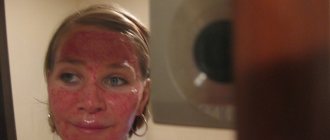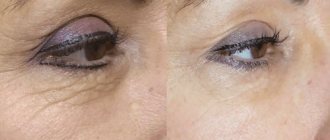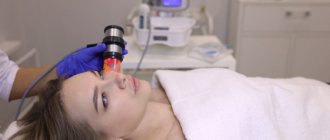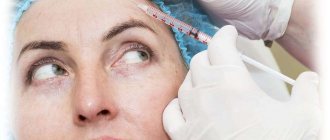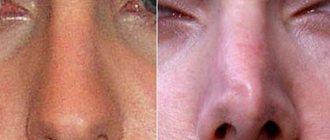What is hyaluronic acid used for? In what procedures is it used?
Non-cross-linked hyaluronic acid is used in cocktails for needle mesotherapy because it quickly decomposes in the dermis, moisturizing it and increasing tension, for example, when used in combination with calcium hydroxyapatite, as well as lightening, in combination, for example, with amino acids.
On the other hand, cross-linked hyaluronic acid, depending on the degree of cross-linking and cross-linking agent, is an excellent material for filling volumetric losses. Such drugs are used for lip augmentation, modeling cheeks, facial contours, chin, and labia. To obtain a beautiful and long-lasting effect in these cases, hyaluronic acid should be injected deeper, that is, subcutaneously or inside fat deposits, or even deeper into the periosteum.
Hyaluronic acid injection – what does the procedure look like?
We perform hyaluronic acid treatments on healthy adult patients. The cross-linked acid is a temporary tissue implant, so the patient should not have any infection. The drug should also not be administered during dental treatment and for at least 2 weeks after its completion.
Hyaluronic acid injection – what the procedure looks like
After examination and consultation, makeup is thoroughly removed from the face, then the skin is disinfected. Depending on your needs, you can apply a numbing cream. Some treatments do not require anesthesia at all, and there are also medications that contain anesthetics. For more precise administration, the doctor marks landmarks on the skin with a special marker pen, this will help achieve an optimal aesthetic effect during the procedure.
Needle mesotherapy involves intradermal injection of a selected cocktail with a needle. Volume replenishment can be done using a needle or cannula.
The amount of preparation depends on the progress of the correction we want to make.
How does the lip augmentation procedure with hyaluronic acid work?
Nowadays, lip augmentation with hyaluronic acid is considered one of the most popular treatment methods in the field of aesthetic medicine. Cross-linked acid can be delivered to the lip area in a variety of ways. This corresponds to the effects we want to achieve during treatment.
To correct, for example, asymmetry, a needle and cannula are used. The cannula works well for narrow but symmetrical lips that primarily require adding volume. There are three methods of introducing hyaluronic acid - linear, point and micro. They can also be combined.
Hyaluronic acid result
Is it possible to enlarge lips during pregnancy?
Many girls got used to constant filler injections before pregnancy, and decide to inject them again during pregnancy. Fillers act locally and should not pass into breast milk or cross the placental barrier, but due to the lack of confirmed scientific data on the safety of such a procedure, it is not recommended.
- Due to hormonal fluctuations and swelling, lips can change shape during pregnancy. As a result, after childbirth, when appearance returns to normal, they will look unaesthetic. Asymmetry may even appear.
- An altered metabolism can lead to the fact that the fillers will dissolve in a month or two, and the procedure will simply be useless.
Therefore, lip augmentation during this period is not worth it due to medical contraindications and the unpredictability of the result.
Filling wrinkles with hyaluronic acid – how does it work?
We use botulinum toxin (Botox) to smooth out fine lines and wrinkles, and once deep wrinkles are eliminated, we can rejuvenate and smooth the skin with hyaluronic acid. It is usually injected linearly, subcutaneously, to “push out” the wrinkle.
Keep in mind that not all wrinkles can be corrected with hyaluronic acid. To remove difficult, deep wrinkles, you need to influence the quality of the skin, using, for example, fractional CO2 laser, mesotherapy or procedures using platelet-rich plasma.
Chemical peels and lasers
During pregnancy, women often experience dark patches of hyperpigmentation on their faces and increased hair growth on their arms and legs. The expectant mother has a desire to change her appearance for the better with the help of cosmetology. However, this should not be done. Although the laser is safe and does not penetrate the skin very deeply, its effects on the body during pregnancy have not been studied.
A study commissioned by the International Journal of Women's Dermatology found that superficial peels using glycolic and lactic acids are safe. The substances penetrate the skin only superficially and therefore do not penetrate into the blood or milk.
Masks with fruit juices, sour milk and other natural ingredients will not hurt either. You can use cosmetics - creams, masks, serums, if they are not contraindicated for pregnant and lactating women.
Mask made from natural ingredients
During pregnancy and breastfeeding, the medium peeling procedure, which uses trichloroacetic and salicylic acids, should be avoided. They have a more pronounced effect on the body and can penetrate the bloodstream.
On the issue of resuming cosmetology procedures, all experts were clear - they recommend making an appointment with a cosmetologist only after pregnancy and breastfeeding have ended. During this period, the main thing is safety, and beauty can wait.
But, if a woman has undergone a cosmetic procedure without knowing about her interesting situation, there is no need to worry about it. As practice shows, the increase in the risk of complications in this situation is extremely insignificant. But it’s still better not to take risks, so specialists at the Center for Aesthetic Medicine recommend postponing such effects for a while and returning to them after the end of lactation.
Share link:
Nose correction with hyaluronic acid – is it possible?
The nose is a part of the face that is of great importance for the perception of appearance, hence the great interest in both plastic surgery and minimally invasive methods of improving its appearance.
The nose can be corrected with hyaluronic acid, but this requires a lot of experience and precision, as well as a sense of aesthetics - sometimes the nose appears more massive after the injection of acid. The most common indications for the use of crosslinked acid in this area are to correct a hump and lift a drooping nasal tip.
Depending on the anatomical situation, acid is injected into the nasal area using a needle or cannula.
How does hyaluronic acid work under the eyes?
Cross-linked hyaluronic acid in the eye area is most often injected to correct tear troughs, that is, a depressive condition that occurs in almost every person with age. This is due to the disappearance of fat deposits in this area. But patients must be carefully selected for this procedure, as the acid can be visible through the thin skin of the lower eyelids. The procedure may also worsen lymphedema if a person is prone to it.
In addition, the acid in this area usually takes a long time to work. There are medications on the market that are specifically designed to fill the tear trough.
Interestingly, the aesthetics of the under-eye area is significantly improved by improving the quality of the skin of the lower eyelids. This is one reason why patients struggling not so much with volume loss, but with gray, tired skin, are recommended to undergo a series of CO2 laser or mesotherapy treatments.
Mesotherapy around the eyes before and after
Breast augmentation using lipofilling
During the lipofilling process, your own fat cells are moved from one area (for example, buttocks) to the breasts. This is one of the safest correction methods. With its help, using your own resources, you can create more advanced forms in several problem areas at once.
The only drawback of such an increase may be that the result is not always predictable, since fat can migrate from the injection site or be absorbed.
Breastfeeding after lipofilling is no different from usual and no special preparation is required. But as is the case with any breast surgery, it is advisable that at least a year pass after the intervention.
What are the contraindications to the injection of hyaluronic acid?
Absolute temporary contraindications for treatment with cross-linked hyaluronic acid, that is, for placement of an absorbable implant in the tissue, include:
- pregnancy and breastfeeding;
- any active infections, including colds, urinary tract infections, herpes, etc.;
- active tumor, radiotherapy and chemotherapy;
- poorly controlled hypertension, diabetes, other chronic diseases;
- period 2 weeks before and 2 weeks after dental procedures (including sandblasting, whitening, etc.);
- period of exacerbation of certain autoimmune diseases.
Permanent, absolute contraindications are:
- hypersensitivity to any component of the drug;
- unrealistic expectations regarding the effect of treatment;
- increased tendency to form hypertrophied scars;
- chronic kidney disease at stage 5;
- cirrhosis of the liver;
- AIDS.
How is rehabilitation after treatment with hyaluronic acid? What should the patient do?
In general, you should not massage the treated areas yourself unless your doctor tells you otherwise. The patient should not visit the sauna, swimming pool or gym for a week. After 2 weeks, a follow-up visit is recommended to assess the final effect of treatment. In case of large swelling, the treated areas can be cooled.
The patient should see a doctor if there is pain that does not go away after using over-the-counter pain relievers or if the treated area turns white. In this case, you must immediately inform the doctor who performed the procedure.
Facial mesotherapy. Photos before and after
Correction of the nipple-areolar complex
Nipple and areola surgery may be necessary if the nipple is asymmetrically positioned, has an irregular shape, nipple hypertrophy or the areola is too large. Correction of an inverted nipple may be necessary so that a woman can breastfeed, otherwise the baby will not be able to drink milk.
Such interventions can be performed separately or in conjunction with breast augmentation, reduction, breast lift, as well as reconstructive mammoplasty after breast removal.
They try to carry out the operation so that the nipple retains sensitivity - then breastfeeding will improve without any particular difficulties.
Breastfeeding is impossible only with complete removal of the mammary glands. In all other situations it can be restored at least partially.
No one can plan their whole life. But it is quite possible to foresee the consequences of the operations you decide to undertake. The main thing is that your partner on the path to beauty and health is a reliable doctor who will do everything to ensure that you retain the capabilities inherent in nature.
Hyaluronic acid – complications after incorrectly performed procedures
Contrary to popular belief, hyaluronic acid injections are not completely safe. The greatest risks are associated with incorrect administration of cross-linked drugs. In extreme cases, it can block an artery, leading to necrosis of the skin and deeper structures, and even blindness if the drug moves into the ophthalmic artery or thrombosis of the ophthalmic artery due to obstruction of another vessel connected to it.
Therefore, such procedures should only be performed by a physician in a treatment room with appropriate medications, including hyaluronidase, which, if administered immediately, can prevent the development of the aforementioned tragic complications.
Complications of hyaluronic acid can also be infectious, such as abscess formation or biofilm formation, which should be treated accordingly.
Very rare, but allergic complications occur - from swelling, rash, formation of granulomas to anaphylactic shock. Although usually these are reactions not to the acid itself, but to other components of the drug. To exclude such consequences, the doctor does tests before the procedure.
Why is it not advisable to get Botox injections during pregnancy and breastfeeding?
As Dr. Naidu explained, there have been no clinical trials examining the effects of the botulinum toxin found in Botox, Dysport, Juvo and Xeomin on pregnant women. Despite this, anecdotal evidence and clinical practice have led many experts to conclude that Botox and similar drugs administered during pregnancy will not cause harm.
Botox injections
One study showed that the botulinum toxin molecule is so heavy that it is extremely difficult for it to penetrate the placenta. In theory, it should be safe to use during pregnancy. But due to the lack of confirmed data on the absence of complications, it is better not to take risks.
Another New York-based scientist, Dr. Morgan Rabach, said he would never administer drugs like Botox to breastfeeding mothers because it is unknown whether they pass into milk. This is why such beauty injections are not given during lactation.





